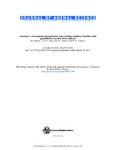Use este identificador para citar ou linkar para este item:
http://www.alice.cnptia.embrapa.br/alice/handle/doc/917436Registro completo de metadados
| Campo DC | Valor | Idioma |
|---|---|---|
| dc.contributor.author | MATTAR, M. | pt_BR |
| dc.contributor.author | SILVA, L. O. C. da | pt_BR |
| dc.contributor.author | ALENCAR, M. M. de | pt_BR |
| dc.contributor.author | CARDOSO, F. F. | pt_BR |
| dc.date.accessioned | 2012-03-05T11:11:11Z | pt_BR |
| dc.date.accessioned | 2012-03-05T11:11:11Z | pt_BR |
| dc.date.available | 2012-03-05T11:11:11Z | pt_BR |
| dc.date.available | 2012-03-05T11:11:11Z | pt_BR |
| dc.date.created | 2012-03-05 | pt_BR |
| dc.date.issued | 2011 | pt_BR |
| dc.identifier.citation | Journal of Animal Science, v. 89, p. 2349-2355, 2011. | pt_BR |
| dc.identifier.uri | http://www.alice.cnptia.embrapa.br/alice/handle/doc/917436 | pt_BR |
| dc.description | The objective of this study was to investigate the presence of genotype × environment interactions (G×E) for long-yearling weight in Canchim cattle (5/8 Charolais + 3/8 zebu) in Brazil using reaction norms (RN). The hierarchical RN model included the fixed effect of age of the animal (linear coefficient) and random effects of contemporary groups and additive animal genetic intercept and slope of the RN and contemporary group effects as random effects. Contemporary groups as the most elemental representation of management conditions in beef cattle were chosen to represent the environmental covariate of the RN. The deviance information criteria demonstrated that a homoskedastic residual RN model provided a better data fit compared with a heteroskedastic counterpart and with a traditional animal model, which had the worst fit. The environmental gradient for long-yearling weight based on contemporary group effects ranged from ?105 to 150 kg. The additive direct variance and heritability estimates increased with increasing environmental gradient from 74.33 ± 22.32 to 1,922.59 ± 258.99 kg2 and from 0.08 ± 0.02 to 0.68 ± 0.03, respectively. The high genetic correlation (0.90 ± 0.03) between the intercept and the slope of the RN shows that animals with the greatest breeding values best responded to environmental improvement, characterizing scale effect as the source of G×E for long-yearling weight. The phenotypic plasticity demonstrated by the slope of the RN of the animal indicates the possibility to change genotype expression along the environmental gradient through selection. The results demonstrate the importance of accounting for G×E in the genetic evaluation of this population. | pt_BR |
| dc.language.iso | por | pt_BR |
| dc.rights | openAccess | pt_BR |
| dc.subject | Genotypex interaction | pt_BR |
| dc.subject | Long-yearlin weight | pt_BR |
| dc.subject | Canchim cattle | pt_BR |
| dc.subject | Reaction norm | pt_BR |
| dc.title | Genotype × environment interaction for long-yearling weight in Canchim cattle quantified by reaction norm analysis. | pt_BR |
| dc.type | Artigo de periódico | pt_BR |
| dc.date.updated | 2012-03-05T11:11:11Z | pt_BR |
| dc.subject.nalthesaurus | beef cattle | pt_BR |
| riaa.ainfo.id | 917436 | pt_BR |
| riaa.ainfo.lastupdate | 2012-03-05 | pt_BR |
| dc.contributor.institution | MAIRA MATTAR, FUNDAÇÃO EDUCACIONAL DE BARRETOS/ BARRETOS; LUIZ OTAVIO CAMPOS DA SILVA, CNPGC; MAURICIO MELLO DE ALENCAR, CPPSE; FERNANDO FLORES CARDOSO, CPPSUL. | pt_BR |
| Aparece nas coleções: | Artigo em periódico indexado (CNPGC)  | |
Arquivos associados a este item:
| Arquivo | Descrição | Tamanho | Formato | |
|---|---|---|---|---|
| MattarJAS2349.full.pdf | 973,78 kB | Adobe PDF |  Visualizar/Abrir |









